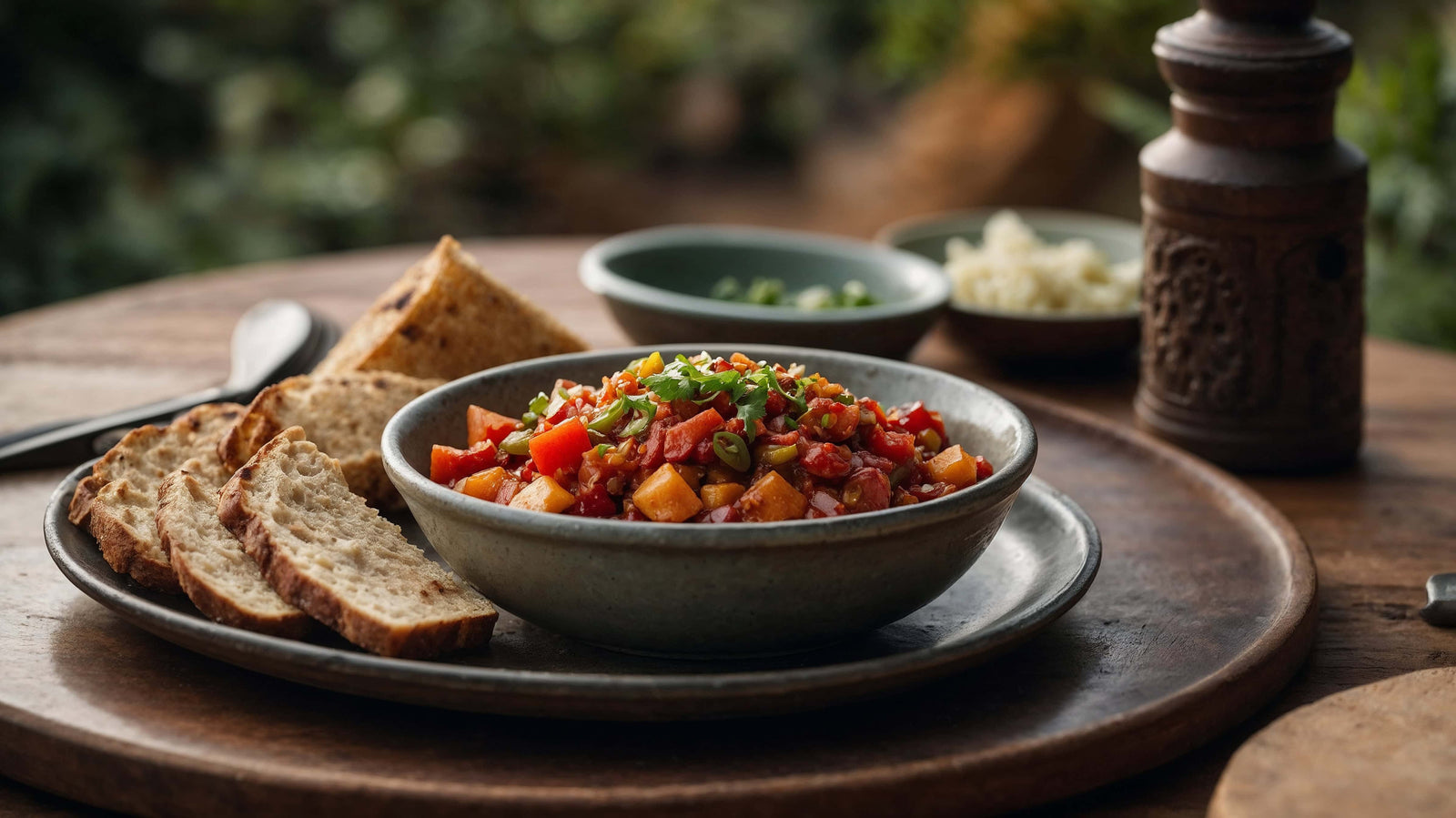Chakalaka: South African Spicy Vegetable Relish Recipe
Chakalaka, a vibrant and spicy vegetable relish, has woven its way into the heart of South African cuisine. This beloved South African dish dish is not only a staple at gatherings and celebrations but also a testament to the country's rich cultural tapestry. Perfectly paired with braai (barbecue), grilled meats, or pap (south african maize meal porridge), Chakalaka is a flavourful journey through the tastes of South Africa. Its preparation, involving a harmonious blend of diced vegetables and spices, encapsulates the spirit of South African communal cooking and eating traditions.
What is Chakalaka?
Chakalaka stands as a quintessential South African dish, embodying a blend of fresh ingredients like chopped vegetables, beans, tomatoes, and a rich mix of seasonings. Its role extends beyond that of a mere relish, serving as a vibrant addition to various dishes. The dish's popularity during celebrations and its status as a braai essential highlight its cultural significance. Born from the innovation of gold mine workers, Chakalaka is a testament to the creativity and resilience of the South African people, transforming fresh ingredients into a dish celebrated nationwide.
Chakalaka Origins and the History of Chakalaka
The roots of Chakalaka trace back to the gold mines of South Africa, where mine workers concocted a filling and flavourful chakalaka recipe from available vegetables and canned beans. This creation was not only a means of nourishment but also a symbol of cultural resilience and unity among the workers. Over time, the Chakalaka recipe evolved, absorbing influences from various South African communities, thus becoming a rich tapestry of the nation's culinary heritage.
Defining Chakalaka: More Than Just a Condiment
Chakalaka defies simple categorisation; it is one of the South African recipes that can assume the role of a salsa, a main, a condiment, or a relish, depending on its preparation. The ingredients' proportions dictate its final form, ranging from a more vegetable-heavy salad to a soupy mixture rich in tomato sauce. This flexibility in its preparation underscores Chakalaka's unique position in South African food, where it adapts to the needs and tastes of its people.
The Core Ingredients That Make Chakalaka Stand Out
At its heart, this African chakalaka dish is a celebration of simplicity and flavour, made with a base of chopped vegetables, bell peppers, tomatoes, beans, and a blend of seasonings. This South African dish's distinctiveness lies in its combination of ingredients, which are readily available yet capable of creating a relish that is both hearty and flavourful. The harmonious blend of spices with the fresh produce results in a dish that is deeply embedded in the country's culinary traditions, enjoyed widely during gatherings and an indispensable companion to starchy sides.
Traditional Chakalaka
Creating the perfect chakalaka recipe involves more than just combining the Chakalaka ingredients; it's about capturing the essence of South African culinary tradition. The process, while straightforward, requires attention to detail and respect for the dish's cultural heritage, ensuring that each spoonful is a tribute to the vibrant flavours and history of South Africa that originated in the township of Johannesburg.
How to make Chakalaka
The journey to making homemade Chakalaka begins with gathering the right ingredients and preparing them with care. This guide aims to walk you through each step, ensuring that the end result is a relish that brings a piece of South African food into your home.
Essential Ingredients for Authentic Flavor
The foundation of this spicy Chakalaka recipe robust flavour lies in its essential ingredients: green peppers, chili peppers, tomatoes, onion finely chopped and a mix of beans, enlivened with a blend of spices. These elements come together to create a relish that is as colourful as it is flavourful, embodying the warmth and spirit of South African food.
Traditional South African Chakalaka Recipe
Serves: 6-8 | Prep Time: 15 minutes | Cook Time: 30 minutes
Chakalaka Ingredients:
-
2 tablespoons cooking oil (sunflower or vegetable)
-
1 large onion, finely chopped
-
1 red pepper, deseeded and chopped
-
1 green pepper, deseeded and chopped
-
3 medium carrots, grated
-
2 cloves garlic, minced
-
2 teaspoons mild curry powder
-
1 teaspoon paprika
-
1 teaspoon ground cumin
-
1 can (410g) baked beans in tomato sauce
-
2 medium tomatoes, roughly chopped
-
1 tablespoon tomato paste
-
1 fresh chili (optional), finely chopped
-
Salt and pepper to taste
-
Fresh coriander for garnish
Chakalaka Recipe Instructions:
-
Prepare the Base:
Heat the oil in a large pan or pot over medium heat. Add the chopped onion and cook until softened and golden, about 5 minutes. -
Add Aromatics:
Stir in the minced garlic, curry powder, paprika, and cumin. Cook for 1-2 minutes until the spices are fragrant. -
Incorporate Vegetables:
Add the deseeded and chopped bell peppers and grated carrots to the pan. Cook for 5-7 minutes, stirring occasionally, until the vegetables start to soften. -
Tomato Mixture:
Add the chopped tomatoes, tomato paste, and chili (if using). Stir well and cook for another 5 minutes, allowing the tomatoes to break down. -
Add canned Baked Beans:
Pour in the baked beans, mixing everything together thoroughly. Reduce the heat to low and simmer for 10-15 minutes, stir to combine. Add a little water if the mixture becomes too thick. -
Season and Garnish:
Taste and season with salt and pepper. Sprinkle with fresh coriander before serving.
Serving Suggestions
-
Serve warm as a side dish with pap, braaied meat, or bread.
Variations to the Classic African Chakalaka Dish
Chakalaka welcomes personalization, with variations that can include different types of beans, additional vegetables, or a tweak in the heat level to suit individual tastes. These adjustments are encouraged, allowing each batch of the Chakalaka recipe to reflect the unique preferences of its maker. Serving it at room temperature can enhance the flavours, making it an adaptable dish to various meals.
Shelf Life: Maximizing Freshness and Flavor
Proper storage is key to preserving Chakalaka's freshness and flavour, ensuring that this beloved dish can be enjoyed to its fullest.
Best Practices for Storage
To maximize Chakalaka's shelf life, it should be stored in an airtight container in the refrigerator, where it can keep for up to a week. For longer storage, freezing is an option, though it's best enjoyed fresh to fully appreciate its vibrant flavours and textures.
The Versatility of Chakalaka
Chakalaka's appeal lies in its versatility, serving as a dynamic accompaniment to a wide range of dishes. This adaptability ensures that Chakalaka remains a cherished component of South African cuisine, capable of enhancing any meal with its spicy, flavourful presence.
Chakalaka as a Culinary Chameleon
Chakalaka seamlessly transitions between roles in the culinary world, from a side dish to a main course, showcasing its ability to complement a variety of meals. Its versatility is a testament to the dish's integral place in the rich tapestry of South African cuisine.
From Side Dish to Main Course: Serving Suggestions
Chakalaka is traditionally served alongside grilled meats or to accompany pap the South African maize porridge, but its uses extend far beyond. It can elevate a simple rice dish, serve as a vibrant topping for baked potatoes, or even take centre stage as a hearty main like Chakalaka and bread. The inclusion of freshly chopped herbs just before serving can enhance its flavours, making it a versatile addition to any culinary occasion.
Mastering Chakalaka at Home
Creating Chakalaka at home invites a journey into South African food traditions, allowing for personal touches along the way. Starting with the fresh ingredients lays the foundation for a vibrant and flavorful relish. The process involves a careful balance of sautéing and simmering to ensure the fresh veggies retain their texture while absorbing the rich spices. Homemade Chakalaka recipes not only bring a piece of South African food heritage into the kitchen but also offers a versatile side dish that can elevate any meal, from casual gatherings to festive celebrations. Embracing this dish at home opens up endless possibilities for exploration and enjoyment.
Expert Tips and Tricks for the Perfect Batch
For those looking to master the art of Chakalaka, starting with fresh ingredients is paramount. This not only enhances the overall flavor profile but also contributes to the relish's vibrant appearance. Monitoring the cooking process carefully ensures that the vegetables are perfectly cooked, maintaining their texture without becoming mushy. To achieve the ideal consistency, one might need to adjust the liquid content by adding a bit of vegetable stock if too thick or allowing it to simmer uncovered if too thin. Keeping the heat at the right level after sautéing is crucial to prevent burning, ensuring a perfectly balanced dish.
Common Mistakes to Avoid in Chakalaka Preparation
Avoiding common pitfalls can make the difference between a good Chakalaka and a great one. Overcooking the vegetables is a frequent mistake, leading to a mushy texture that detracts from the relish's appeal. Another error is underestimating the spice levels; Chakalaka should have a kick but remain enjoyable. Not allowing the flavors to meld together by rushing the cooking process can result in a less harmonious dish. Lastly, neglecting the balance of acidity and sweetness can impact the final taste, so it's important to taste and adjust seasoning as needed.
The Cultural Significance of Chakalaka
Chakalaka is more than just a dish; it's a vibrant expression of South African culture and history. Originating in the gold mines surrounding johannesburg, it symbolizes the ingenuity and resilience of the miners who created a flavorful, nourishing meal with limited ingredients. Today, Chakalaka continues to be a staple at gatherings, celebrations, and everyday meals, reflecting the nation's diversity and culinary creativity. Its evolution from Mozambican mineworkers region and family tradition influened a beloved national dish underscores the dynamic nature of South African society and its ability to adapt and flourish.
Chakalaka in the South African Culinary Landscape
Chakalaka is a traditional South African relish that has become an indispensable part of the nation's culinary identity. This spicy, tangy vegetable mix, seasoned with an array of spices, embodies the rich cultural tapestry of South Africa. Its presence on tables across the country, from humble homes to grandiose celebrations, speaks to its versatility and widespread appeal. Chakalaka recipes may vary from region to region, each adding a unique twist, but the core ingredients remain a testament to its enduring legacy within South African cuisine.
Chakalaka Today: From Traditional Roots to Contemporary Tables
From its traditional roots, Chakalaka has found its way onto contemporary tables, evolving while still maintaining its essence. Modern interpretations of the dish allow for creativity, incorporating new ingredients and catering to a broader palate. However, its core—spicy, tangy, and deeply flavorful—remains unchanged, serving as a bridge between past and present. As it garners attention beyond South Africa's borders, Chakalaka continues to be a symbol of the nation's culinary diversity, showcasing the rich heritage and dynamic future of South African food culture.
Your Chakalaka Questions Answered
Chakalaka, a staple in South African cuisine, often raises questions about its classification. Its versatility means it can serve as a relish, condiment, or even a main course depending on its preparation. The ingredients and consistency of Chakalaka can vary widely, making it adaptable to different dietary needs and meal types. Understanding its multifaceted nature helps appreciate its place in South African culture and cuisine, highlighting the dish's ability to bring people together through its shared enjoyment and diverse interpretations.
Is Chakalaka a Salad, Soup, or Condiment?
Chakalaka occupies a unique place in culinary categorization, embodying features of a salad, soup, and condiment. Its preparation and presentation can shift its role from a spicy relish accompanying meats to a vibrant standalone salad or a rich, soup-like dish. This versatility underscores Chakalaka's adaptability and the creativity inherent in South African cooking. The dish's categorization ultimately depends on its consistency and how it complements the meal, reflecting the dynamic nature of this beloved South African specialty.
How to Adapt Chakalaka for Various Dietary Needs
Adapting Chakalaka to cater to various dietary needs is straightforward, thanks to its vegetable-based composition. For those seeking a plant-based option, versions include beans and vegetables without animal products is key. For lower-calorie versions, reducing the amount of vegetable oil and opting for fresh tomatoes over canned tomatoes can make a significant difference. The dish's inherent flexibility not only allows for dietary accommodations but also encourages experimentation, making Chakalaka a versatile and inclusive option for any table.
Chakalaka Beyond the Borders
Chakalaka's journey beyond South African borders illustrates its universal appeal and adaptability. As the dish enters global cuisine, it carries with it the flavors, history, and cultural significance of its homeland. International chefs and food enthusiasts embrace Chakalaka, often incorporating local ingredients and culinary techniques, thus contributing to its evolution while respecting its origins. This global journey not only introduces Chakalaka to new audiences but also reaffirms the power of food to transcend geographical and cultural boundaries.
Where to Find Authentic Chakalaka Experiences Worldwide
Finding authentic Chakalaka experiences worldwide has become easier as the dish gains international fame. From South African restaurants in major cities to culinary festivals that celebrate global cuisines, Chakalaka is making its presence known. Food enthusiasts seeking the authentic taste of this South African spicy vegetable relish can often find it at places that prioritize region and family tradition recipes and cooking methods. Additionally, online communities and cooking platforms offer resources and recipes for those looking to recreate the Chakalaka experience at home, bridging distances and bringing the flavors of South Africa to global audiences.
A Toast to Chakalaka: Embracing South Africa's Culinary Gem
Chakalaka is much more than a traditional South African vegetable relish; it's a vibrant celebration of the nation's rich cultural tapestry and culinary innovation. It originated in the townships of Johannesburg, this spicy, tangy, and flavourful dish has woven its way into the hearts of many, showcasing the soul of South African food. At its core, the chakalaka recipe embodies the spirit of community and resilience, having been a staple among gold mines surrounding johannesburg and the Mozambican mineworkers who sought to enliven their meals with something hearty and flavourful.
Today, whether served warm or served cold, alongside grilled meats or the beloved South African maize porridge, chakalaka continues to stand out for its versatility and its ability to bring people together. Its unique blend of fresh veggies, canned baked beans, carrots and peppers, and a kick of cayenne pepper, all simmered in cooking oil with a touch of curry paste, highlights the creativity and adaptability of South African recipes. As we raise our glasses to chakalaka, we're not just celebrating a dish; we're honouring a symbol of South African heritage that continues to inspire culinary enthusiasts around the world.



